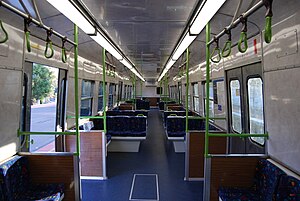Hitachi (Australian train)
| Hitachi | |
|---|---|

A Metro Trains refurbished Hitachi crosses Merri Creek
|
|

Refurbished Hitachi interior
|
|
| In service | December 1972–September 2008 November 2008–April 2014 |
| Manufacturer | Commonwealth Engineering (electrics), Bayswater (bodies), Martin & King Somerton ('M' car fitout), Newport Workshops (fitout and Trailers) |
| Replaced | Swing Door cars, Tait cars |
| Constructed | 1972–1981 |
| Scrapped | 2003–2014 |
| Number built | 118 (3 car sets) |
| Number in service | 0 |
| Number preserved | 48 (3 car sets) |
| Formation | M-T-T-M D-M, later M-T-M M-T-M |
| Fleet numbers | 273–300 (Motors), 1901–2017 (Trailers), 1–237 (Former Motor Numbers), 301-368 (Former Driving Trailers) |
| Capacity | 536 seated (6 car) |
| Operator(s) | Historically Victorian Railways and successors, MTA, PTC, M>Train, Connex and Metro Trains Melbourne |
| Depot(s) | Newport Workshops (late 2015) |
| Line(s) served | All Melbourne suburban |
| Specifications | |
| Car body construction | Fluted stainless steel |
| Car length | 23,406 mm (76 ft 9.5 in) over couplers |
| Width | 2,972 mm (9 ft 9.0 in) |
| Height | 3,759 mm (12 ft 4.0 in), not including pantograph |
| Floor height | 1,194 mm (3 ft 11.0 in) |
| Articulated sections | Open gangway |
| Maximum speed | 113 km/h (70 mph) |
| Weight | 41 tonnes (40 long tons; 45 short tons) |
| Traction system | 4 x Hitachi HS 834 Springbourne (150 hp or 110 kW) per M car |
| Power output | 450 kW (600 hp) per M car 1,790 kW (2,400 hp) per 6 car set |
| Acceleration | 0.85 m/s2 (2.8 ft/s2) |
| Electric system(s) | 1.5 kV DC Overhead line |
| Current collection method | Stone-Faiveley ‘V’-type pantograph (original builds) Metropolitan-Vickers 'Diamond'-type pantograph (used as replacements) |
| Coupling system | Janney coupler |
| Track gauge | 1,600 mm (5 ft 3 in) |
Hitachi electric multiple unit trains operated on the suburban railway network of Melbourne, Australia between 1972 and 2014. Electrical equipment was supplied by Commonwealth Engineering to designs by Hitachi of Japan, leading to their official name today, though no actual Hitachi-supplied components were used in their construction. Hitachi trains have been also known as Martin & King or Stainless Steel trains officially. They were colloquially referred to as ghosties by many Victorian youth, due to their ageing appearance and scarcity when in use. They were the last suburban trains in Melbourne with no air conditioning, and with windows that could be opened.
The single-deck Hitachi trains operated as ‘M-T-M-M-T-M’ sets of six carriages (two coupled sets of three carriages arranged with two motorised carriages on either end of a motorless ‘trailer’ carriage).
Based on a successful trial of longer Harris trailer cars built between 1967 and 1971, the Hitachi train used carriages 22.86 m (75.0 ft) long, up from the standard 17.98 m (59.0 ft) length of the earlier suburban cars. The revised carriage design enabled a six car Hitachi train to seat 560 passengers, up from 540 for a seven car Harris train. The maximum load for a Hitachi was 1,500 passengers, 300 more than a Harris.
As delivered, Hitachi trains were composed of three types of carriage, M (motor carriages including a driver's cabin at one end), T (trailer carriages with no motors), and D (a trailer carriage with a small driver's cabin). These cars were arranged in sets of M-T-T-M and M-D, which could be arranged together to create a six car set. All but one of the #68 D carriages produced were later converted into T carriages. (The exception being D #353 was involved in a collision at Pakenham, that also resulted in the scrapping of Guard's Van Z 286) The first M and D carriages delivered were provided with nose doors at the front of the cab. These were later removed from the early carriages, and the feature was omitted from later sets.
...
Wikipedia
